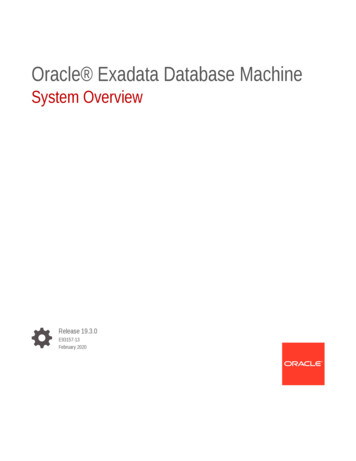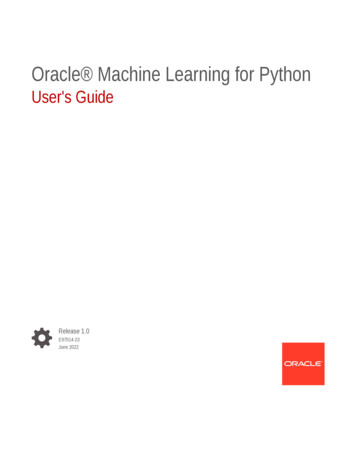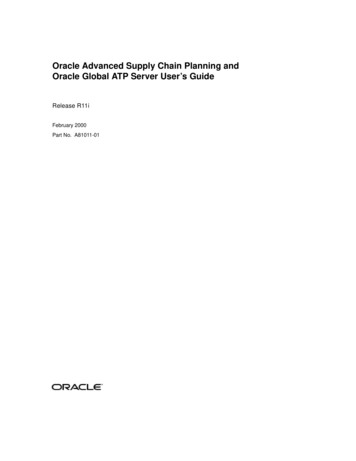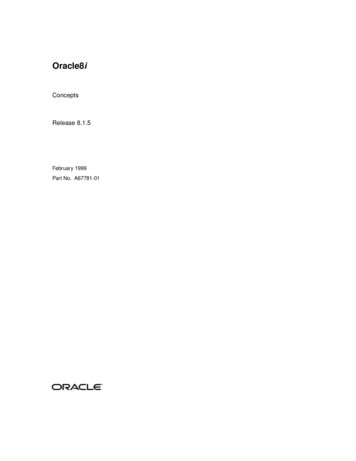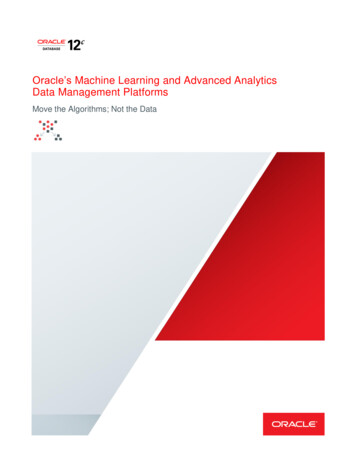
Transcription
Oracle’s Machine Learning and Advanced AnalyticsData Management PlatformsMove the Algorithms; Not the DataORACLE WHITE PAPER JULY2017
DisclaimerThe following is intended to outline our general product direction. It is intended for informationpurposes only, and may not be incorporated into any contract. It is not a commitment to deliver anymaterial, code, or functionality, and should not be relied upon in making purchasing decisions. Thedevelopment, release, and timing of any features or functionality described for Oracle’s productsremains at the sole discretion of Oracle.BIG DATA ANALYTICS WITH ORACLE ADVANCED ANALYTICS
Table of ContentsDisclaimer1Executive Summary: Machine Learning Algorithms Embedded in Data ManagementPlatforms1Big Data and Analytics—New Opportunities and New Challenges3Predictive Analytics!3Move the Algorithms, Not the Data5SQL and R Support5In-Database Processing with Oracle Advanced Analytics6Oracle Data Miner Workflow GUI; a SQL Developer extension8Oracle R Enterprise—Integrating Open Source R with the Oracle Database10Hadoop, Oracle Big Data Appliance and Big Data SQL12A Platform for Developing Enterprise-wide Predictive Analytics Applications13Conclusion15BIG DATA ANALYTICS WITH ORACLE ADVANCED ANALYTICS
“Essentially, all models are wrong, but some are useful.”GEORGE BOXFAMOUS TWENTIETH CENTURY STATISTICIANExecutive Summary: Machine Learning Algorithms Embedded in DataManagement PlatformsThe era of “big data” and the “cloud” are driving companies to change. Just to keep pace, they mustlearn new skills and implement new practices that leverage those new data sources and technologies.Increasing customer expectations from sharing their digital exhaust with corporations in exchange forimproved customer interactions and greater perceived value are pushing companies forward. Big dataand analytics offer the promise to satisfy these new requirements. Cloud, competition, big dataanalytics and next-generation “predictive” applications are driving companies towards achieving newgoals of delivering improved “actionable insights” and better outcomes. Traditional BI & Analyticsapproaches don’t deliver these detailed predictive insights and simply can’t satisfy the emergingcustomer expectations in this new world order created by big data and the cloud.Unfortunately, with big data, as the data grows and expands in the three V’s; velocity, volume andvariety (data types), new problems emerge. Data volumes grow and data becomes unmanageableand immovable. Scalability, security, and information latency become new issues. Dealing withunstructured data, sensor data and spatial data all introduce new data type complexities.Traditional advanced analytics has several information technology inherent weak points: data extractsand data movement, data duplication resulting in no single-source of truth, data security exposures,separate and many times, depending on the skills of the data analysts/scientists involved, multipleanalytical tools (commercial and open source) and languages (SAS, R, SQL, Python, SPSS, etc.).Problems become particularly egregious during a deployment phase when the worlds of data analysisand information management collide.Traditional data analysis typically starts with a representative sample or subset of the data that isexported to separate analytical servers and tools (SAS, R, Python, SPSS, etc.) that have beenespecially designed for statisticians and data scientists to analyze data. The analytics they performrange from simple descriptive statistical analysis to advanced, predictive and prescriptive analytics. If1 BIG DATA ANALYTICS WITH ORACLE ADVANCED ANALYTICS
a data scientist builds a predictive model that is determined to be useful and valuable, then IT needs tobe involved to figure out deployment and enterprise deployment and application integration issuesbecome the next big challenge. The predictive model(s)—and all its associated data preparation andtransformation steps—have to be somehow translated to SQL and recreated inside the database inorder to apply the models and make predictions on the larger datasets maintained inside the datawarehouse. This model translation phase introduces tedious, time consuming and expensive manualcoding steps from the original statistical language (SAS, R, and Python) into SQL. DBAs and IT mustsomehow “productionize” these separate statistical models inside the database and/or data warehousefor distribution throughout the enterprise. Some vendors will charge for specialized products andoptions for just for predictive model deployment. This is where many advanced analytics projects fail.Add Hadoop, sensor data, tweets, and expanding big data reservoirs and the entire “data to actionableinsights” process becomes more challenging.Not with Oracle. Oracle delivers a big data and analytics platform that eliminates the traditionalextract, move, load, analyze, export, move load paradigm. With Oracle Database 12c and the OracleAdvanced Analytics Option, big data management and big data analytics are designed into the datamanagement platform from the beginning. Oracle’s multiple decades of R&D investment in developingthe industry’s leading data management platform, Oracle SQL, Big Data SQL, Oracle Exadata, OracleBig Data Appliance and integration with open source R are seamlessly combined and integrated into asingle platform—the Oracle Database.Oracle’s vision is a big data and analyticplatform for the era of big data and cloud to: Make big data and analytics simple(for any data size, on any computerinfrastructure and any variety of data, in anycombination) and Make big data and analytics deploymentsimple (as a service, as a platform, as anapplication)Oracle Advanced Analytics eliminates data movement and combines big data management with big data analytics.2 BIG DATA ANALYTICS WITH ORACLE ADVANCED ANALYTICS
Oracle Advanced Analytics offers a wide library of powerful in-database algorithms and integration withopen source R that together can solve a wide variety of business problems and can be accessed viaSQL, R or GUI. Oracle Advanced Analytics, an option to the Oracle Database Enterprise Edition 12c,extends the database into an enterprise-wide analytical platform for data-driven problems such aschurn prediction, customer segmentation, fraud and anomaly detection, identifying cross-sell and upsell opportunities, market basket analysis, and text mining and sentiment analysis. Oracle AdvancedAnalytics empowers data analyst, data scientists and business analysts to more extract knowledge,discover new insights and make informed predictions—working directly with large data volumes in theOracle Database.Data analysts/scientists have choice and flexibility in how they interact with Oracle AdvancedAnalytics. Oracle Data Miner is an Oracle SQL Developer extension designed for data analysts thatprovides an easy to use “drag and drop” workflow GUI to the Oracle Advanced Analytics SQL datamining functions (Oracle Data Mining). Oracle SQL Developer is a free integrated developmentenvironment that simplifies the development and management of Oracle Database in both traditionaland Cloud deployments. When Oracle Data Miner users are satisfied with their analyticalmethodologies, they can share their workflows with other analysts and/or generate SQL scripts to handto their DBAs to accelerate model deployment. Oracle Data Miner also provides a PL/SQL API forworkflow scheduling and automation.R programmers and data scientists can use the familiar open source R statistical programminglanguage console, RStudio or any IDE to work directly with data inside the database and leverageOracle Advanced Analytics’ R integration with the database (Oracle R Enterprise). Oracle AdvancedAnalytics’ Oracle R Enterprise provides transparent SQL to R translation to equivalent SQL and OracleData Mining functions for in-database performance, parallelism, and scalability—this making R readyfor the enterprise.Application developers, using the ODM SQL data mining functions and ORE R integration can buildcompletely automated predictive analytic solutions that leverage the strengths of the database and theflexibly of R to integrate Oracle Advanced Analytics analytical solutions into BI dashboards andenterprise applications.2 BIG DATA ANALYTICS WITH ORACLE ADVANCED ANALYTICS
By integrating big data management and big data analytics into the same powerful Oracle Database12.2c data management platform, Oracle eliminates data movement, reduces total cost of ownershipand delivers the fastest way to deliver enterprise-wide predictive analytics solutions and applications.Big Data and Analytics—New Opportunities and New ChallengesGartner characterizes big data as: "high volume, velocity, and/or variety information assets that demand new,innovative forms of processing for enhanced decision making, business insights or process optimization." However,for many, this is not new. Companies have been data mining large volumes of data for years. What’s been newand more challenging is the increasing pace of the “big data” volumes, velocities and varieties of sources coupledwith new customer expectations of what new “actionable insights” can be achieved. This places new demands onInformation Technology (IT) departments, data scientist and data analysts and the departments and lines ofbusiness they support e.g. marketing, customer service, support, R&D and operations.Unfortunately, as big data grows and expands over time in its three V’s; velocity, volume and variety, new problemsemerge. Data volumes grow and eventually become near immovable. Eventually at some point, it becomesimpractical to move large data amounts to separate servers for the data analysis. During the big data explosion,many problems are experienced such as data movement, data duplication, security, creation of “data analysissprawl-marts”, separation of data management from data analysis and worse, information latency expands,oftentimes to multiple days and weeks.Traditional data analysis methods contribute to these problems. Data analysts and data scientist typically have theirown special “tools” that they’ve learned to use (SAS, R, SPSS or Python, etc.) so require data extracts from thedatabase /data warehouse, transforms and loads to dedicated, separate analytical servers. If a data scientist buildsa “good” predictive model, then a new problem emerges. Deployment of that model to where and when it is mostneeded and integration into applications e.g. BI dashboards, call centers, websites, ATMs and mobile devicesbecomes the next big challenge for IT. The predictive model(s)—and all the associated data preparation andtransformation steps—have to be recreated in the destination platform to make the predictions on the larger datatables. For Oracle environments, this export, data analysis, import results outer loop complicates the data analysisunnecessarily and introduces the time consuming and expensive model deployment phase. IT is asked to“productionize” the models and re-implement them using SQL inside the database.The challenge is that the models were originally created using a statistical programming language (SAS, R, SPSSand Python.) but to productionize them, they must run as SQL functions inside the database. This is where the bigtime sink occurs and errors can be introduced. For organizations who strive to be leaders, efficient data collection,data management, analysis, and deployment of predictive models, insights and actionable business intelligence arethe keys to their success. Traditional data analysis methods just won’t suffice. Add Hadoop, sensor data, tweets,and ever expanding new data reservoirs and the whole problem just gets worse.Predictive Analytics!Predictive analytics is the process of automatically sifting through large amounts of data to find previously hiddenpatterns, discover valuable new insights and make informed predictions for data-driven problems such as: Predicting customer behaviors, identifying cross-selling and up-selling opportunities Anticipating customer churn, employee attrition and student retention Detecting anomalies and combating potential tax, medical or expense fraud,3 BIG DATA ANALYTICS WITH ORACLE ADVANCED ANALYTICS
Understanding hidden customer segments and understanding customer sentiment, Identifying key factors that drive outcomes and delivering improved qualityPredictive Analytics as a technology has been delivering measurable value for years. Predictive Analytics climbedit’s was up Gartner’s Hype Cycle for Emerging Technologies and reached the Gartner’s enviable “plateau ofproductivity” in 2013. Today in 2015, predictive analytics are being implemented and deployed in enterprises andapplications ranging from predicting churn and employee turnover, to flagging medical fraud and tax non-complianceto targeted selling and real-time recommendation engines. As big data analytics technologies and user adoptionsevolve, mature and expand, predictive analytics use cases and integrated “predictive” applications that push “the artof the possible” are emerging every day and are constantly raising the bar of new user expectations.Oracle Advanced Analytics provides support for these data driven problems by offering a wide range of powerfulworkhorse data mining algorithms that have been implemented in a relational database environment (RDBMS).Algorithms are implemented as SQL functions inside the database. Oracle Advanced Analytics’ data miningalgorithms hence leverage all related SQL features and can mine data in its original star schema representationincluding standard structured tables and views, transactional data and aggregations, unstructured i.e. CLOB datatypes (using Oracle Text to parse out “tokens”) and spatial data. Oracle Advanced Analytics in-database SQL datamining functions take advantage of parallelism inside the database for both model build and model apply, honor allsecurity and user privilege schemes, adhere to revision control and audit tracking database features and can minedata in its native and potentially encrypted form inside the Oracle Database.Oracle’s Machine Learning & Adv. Analytics AlgorithmsCLASSIFICATION– Naïve Bayes– Logistic Regression (GLM)– Decision Tree– Random Forest– Neural Network– Support Vector Machine– Gaussian Mixture ModelsCLUSTERING– Hierarchical K-Means– Hierarchical O-Cluster– Expectation Maximization (EM)ANOMALY DETECTION– One-Class SVMTIME SERIESREGRESSION– Linear Model– Generalized Linear Model– Support Vector Machine (SVM)– Stepwise Linear regression– Neural Network– LASSOATTRIBUTE IMPORTANCE– Principal Comp Analysis (PCA)– Non-negative Matrix Factorization– Singular Value Decomposition (SVD)– Explicit Semantic Analysis (ESA)TEXT MINING SUPPORT– Algorithms support text type– Tokenization and theme extraction– Explicit Semantic Analysis (ESA) fordocument similarityA1 A2 A3 A4 A5 A6 A7– Minimum Description Length– Principal Comp Analysis (PCA)– Unsupervised Pair-wise KL DivASSOCIATION RULESSTATISTICAL FUNCTIONS– Basic statistics: min, max,median, stdev, t-test, F-test,Pearson’s, Chi-Sq, ANOVA, etc.– A priori/ market basketPREDICTIVE QUERIES– Single, Double Exp SmoothingFEATURE EXTRACTION– Predict, cluster, detect, featuresR PACKAGESSQL ANALYTICS– SQL Windows, SQL Patterns,SQL Aggregates– CRAN R Algorithm Packagesthrough Embedded R Execution– Spark MLlib algorithm integration OAA (Oracle Data Mining Oracle R Enterprise) and ORAAH combined OAA includes support for Partitioned Models, Transactional, Unstructured, Geo-spatial, Graph data. etc,Copyright 2017, Oracle and/or its affiliates. All rights reserved. Oracle Advanced Analytics 12.2c data mining functions are implemented as SQL functions that can be accessed by SQL, PL/SQL,R and the Oracle Data Miner GUI.4 BIG DATA ANALYTICS WITH ORACLE ADVANCED ANALYTICS
Move the Algorithms, Not the DataData is big; algorithms are small. Hence, it makes logical sense to move the algorithms to the data rather thanmoving the data to the algorithms. Oracle realized this big data and analytics data challenge in 1999 when itacquired Thinking Machines Corporation’s data mining technology and development team. At that time, Oraclecommenced on a strategy to develop traditional and cutting edge machine learning algorithms and statisticalfunctions as native SQL functions with full SQL language support. With Oracle Advanced Analytics, data miningalgorithms run as native SQL functions; not as PL/SQL scripts, call-outs or extensibility framework add-ins. Modelsare first class database objects that can be built, applied, shared, and audited.In the early 2000’s, starting in Oracle Data Mining Release 9.2i, Oracle’s first data mining algorithms took advantageof available core Database’s strengths—specifically, counting, parallelism, scalability and other databasearchitectural underpinnings. Essentially, the first two Oracle data mining algorithms, Naïve Bayes and A Priorialgorithms, are based on counting principles. They count everything very quickly and then assemble conditionalprobability predictive models—all 100% inside the database. Neither the data, the predictive models nor the resultsever leave the database.OAA Naïve Bayes algorithm can quickly builds predictive models to predict e.g., “Who will churn?”, “Whichcustomers are most likely to purchase Product A?”, or “What is the probability that an item will fail?” Let’s take anexample in a bit more detail for comprehension. Let’s say we are interested in selling Product A (e.g. a motorcycleor 500 shoes, etc.). The Oracle Advanced Analytics data mining algorithms, specifically the Naïve Bayesalgorithm, of all the customers who purchased Product A, it counts how many customers were male vs. female.How many rent an apartment vs. owns their own home? How many have children and how many? Each of theseanswers involves counts that, taken together, can form a complex conditional probability model that accuratelypredicts whom we should target to increase our likelihood of selling more of Product A.OAA’s A Priori “market basket analysis” algorithm counts items in each customer’s transactional “baskets” whilelooking for co-occurring items e.g. A B appear together frequently, and then provides conditional probability ARrules. For example:IF, “Cereal” AND “Bananas” appear in the same customer’s basket,THEN, the “Milk” is also likely to appear in the basket.WITH Confidence 87%, and Support 11%.Armed with these types of new customer insights from Oracle Advanced Analytics, a store could decide to place themilk near the cereal and bananas, offer new promotional “breakfast kit” product bundles or make real-time customerspecific recommendations as the customer checks-out. This is just a simple example of the types of ways that bigdata analytics can find “actionable insights” from data. Obviously, more data, more advanced analyticsmethodologies and fast enterprise wide deployment can open new doors to many new big data and analyticsapplications and solutions possibilities.SQL and R SupportWhere SQL is the standard language for data management and has been for 40 years, for data analysis, variouslanguages compete—R, SAS, Python and SQL and others. SAS, S , SQL, SPSS and Matlab have been long timefavorites, but in recent past years, open source R especially has surged to the top of the pack and Python andothers have emerged. Per the KDD Nuggets data mining industry community annual polls(http://www.kdnuggets.com/polls/), R and SQL currently compete for #1 and #2 positions, respectively.5 BIG DATA ANALYTICS WITH ORACLE ADVANCED ANALYTICS
The good news is that Oracle Advanced Analytics supports both languages—SQL and R. There are legions ofdevelopers who know SQL for data management and Oracle provides support for data mining and advancedanalytics via Oracle Advanced Analytics’ SQL data mining functions and provides tight, industry leading integrationwith open source R statistical programming language.Most Oracle customers are very familiar with SQL as a language for query, reporting, and analysis of structureddata. It is the de facto standard for analysis and the technology that underlies most BI tools. R is a widely popularopen source programming language for statistical analysis that is free and because of that is taught in most datascience educational programs. A growing number of data analysts, data scientists, researchers, and academics startby learning to use R, leading to a growing pool of R programmers who can now work with their data inside theOracle Database using either SQL or R languages.Over the past decade and one-half, Oracle Advanced Analytics has matured and has been developed to now inOracle 12c, the Oracle Advanced Analytics Option delivers nearly twenty scalable, parallelized, in-databaseimplementations of workhorse predictive analytics algorithms. Oracle Advanced Analytics exposes these datamining algorithms as SQL functions that are accessible via SQL, R language and the Oracle Data Miner GUI, anextension to Oracle SQL Developer for the most common data driven problems e.g. clustering, regression,prediction, associations, text mining, associations analysis, etc. All Oracle Advanced Analytics algorithms areimplemented deep inside the database and take full advantage of the Oracle Database’s industry leading scalability,security, SQL functions, integration, ETL, Cloud, structured, unstructured and spatial data types features andstrengths and can be accessed via both SQL and R—and GUI.Hence, you can think of Oracle Advanced Analytics like this Oracle Advanced Analytics extends the SQL language to add powerful analytical verbs e.g. predict, detect, associate, cluster.In-Database Processing with Oracle Advanced AnalyticsOracle Advanced Analytics extends the database into a comprehensive advanced analytics platform for big dataanalytics. With Oracle, powerful analytics are performed directly on data in the database. Results, insights, and realtime predictive models are available and managed by the database.6 BIG DATA ANALYTICS WITH ORACLE ADVANCED ANALYTICS
A data mining model is a schema object in the database, built via a PL/SQL API that prepares the data, learns thehidden patterns to build an OAA model which can then be scored via built-in OAA data mining SQL functions. Whenbuilding models, Oracle Advanced Analytics leverages existing scalable technology (e.g., parallel execution, bitmapindexes, aggregation techniques) and additional developed new Oracle Advanced Analytics and Oracle Databasetechnologies (e.g., recursion within the parallel infrastructure, IEEE float, automatic data preparation for binning,handling missing values, support for unstructured data i.e. text, etc.).Oracle Advanced Analytics 12.2Model Build Time PerformanceOAA 12.2 AlgorithmsRows (Ms)T7-4 (Sparc & Solaris)X5-4 (Intel and Linux)Model Build Time (Secs / Degree of Parallelism)Attributes Importance64028s / 51244s / 72K Means ClusteringExpectation Maximization640159161s / 256455s / 512268s / 144588s / 144Naive Bayes ClassificationGLM ClassificationGLM Regression32064064017s / 256154s / 51255s / 51223s / 72363s / 14493s / 144Support Vector Machine (IPM solver)Support Vector Machine (SGD solver)640640404s / 51284s / 2561411s / 144188s / 72Copyright 2016, Oracle and/or its affiliates. All rights reserved. Oracle Advanced Analytics 12.2 delivers significant performance improvements and can build machine learning models onhundreds of millions of records and hundreds of attributes in seconds or minutes.The true power of embedding data mining functions within the database as SQL functions is most evident whenscoring data mining models. Once the models have been built by learning the hidden patterns in the historical data,applying the models to new data inside the database is blazingly fast. Scoring is then just a row-wise function.Hence, Oracle Advanced Analytics can “score” many millions of records in seconds and is designed to supportonline transactional processing (OLTP) environments.Using Exadata’s “smart scan” technology it gets better. With Oracle Advanced Analytics running in an Exadataenvironment, SQL predicates and OAA predictive models get pushed down to the hardware layer for execution. For Oracle Exadata environments, pushed to Exadata storage level for executionFor Oracle Big Data Appliance (Hadoop) environments, pushed to BDA storage level for execution.In both cases, only those records that satisfy the predicates are pulled from disk for further processing inside thedatabase. For example, find the US customers likely to churn:7 BIG DATA ANALYTICS WITH ORACLE ADVANCED ANALYTICS
Automatic Data Preparation, Data Types, Star Schemas and “Nested Tables”Typically, in order to perform proper analysis on data, analysts have to make explicit decisions about how to “bin”data, deal with missing values and oftentimes reduce the number of variables (feature selection) to be used in themodels. Over the past 15 years, Oracle Advanced Analytics has evolved and now can automate most of the stepstypically required in data mining projects. Today, Automated Data Preparation (ADP) automatically bins numericattributes using default and user customizable binning strategies e.g. equal width, equal count, user-defined andsimilarly bins categorical attributes into N top values and “other” or user-defined bins. Missing values areautomatically replaced by a statistical value (i.e. mean, median, mode, etc.) instead of that record being removedfrom the analysis. ADP is used both for model building and then again for applying the models to new data. Userscan of course override ADP settings if they choose.Oracle Advanced Analytics provides support for attribute reduction (Attribute Importance using the MinimumDescription Length algorithm) and feature reduction techniques (Principal Components Analysis and Non-NegativeMatrix Factorization). However, each of the Oracle Advanced Analytics algorithms (e.g. Decision Trees,Generalized Linear Regression, Support Vector Machines, Naïve Bayes, K-Means Clustering, ExpectationMaximization Clustering, Anomaly Detection 1-Class SVMs, etc.) has their own built-in automated strategies forattribute reduction and selection so the an explicit variable reduction step is optional, but not necessary. Users ofcourse can control algorithm and data preparation settings or accept the intelligent defaults.Transactional data, e.g. purchases, transactions, events, etc. represent much of the data that is important to buildgood predictive models. Oracle Advanced Analytics mines this data in its native transactional form and leveragesthe database’s aggregation functions to summarize it and then feed vector of the data (e.g. item purchases) and joinit to other customer 2-D data to provide a 360 degree customer view. Oracle Advanced Analytics models, e.g.classification, regression and clustering models, ingest this aggregated transactional attribute as a “nested table”.Deep inside the Oracle Advanced Analytics’ in-database processing, records are processed as triplets: Unique ID,Attribute name, and Attribute value. That’s just part of the secret sauce of how Oracle Advanced Analyticsleverages the core strengths of the Oracle Database. Market basket analysis would of course mine this data in itsnative transactional data form (typically not aggregated) to find co-occurring items in baskets.Unstructured data i.e. text is also processed in a similar fashion inside the database. Oracle Advanced Analyticsuses Oracle Text’s text processing capabilities and multi-language support to “tokenize” any CLOB data type e.g.text, Word, Adobe Acrobat, etc. As Oracle Text is a free feature in every Oracle Database, Oracle AdvancedAnalytics leverages it to pre-process unstructured data to then feed vectors of words and word coefficients (TFIDF—term frequency inverse document frequency) into the algorithms. Oracle Advanced Analytics just treats theunstructured attributes as additional input attributes e.g. police comments, physician’s notes, resume, emails, article,abstract, etc. that get joined with everything else (e.g. Age, Income, Occupation, etc.) that is being fed into theOracle Advanced Analytics data mining algorithms. Spatial data, web clicks and other data types can also bejoined and included in Oracle Advanced Analytics data mining models.Oracle Data Miner Workflow GUI; a SQL Developer extensionOracle Data Miner GUI, an extension to Oracle SQL Developer 4.2, is designed for users who prefer an easy to useGUI for their data analysis and don’t necessarily want know have to know how to program in either SQL or R—orjust don’t want to write code. Oracle Data Miner enables data analysts, business analysts and data scientists towork directly with data inside the database using Oracle Data Miner’s graphical “drag and drop” workflow paradigm.Data analysts easily learn how to use Oracle Data Miner and can quickly visualize and explore the data graphically,prepare and transform their data as necessary, build and evaluate multiple data mining models using extensive8 BIG DATA ANALYTICS WITH ORACLE ADVANCED ANALYTICS
model viewing and model evaluation viewers. Then they can apply Oracle Data Mining models to new data fordeployment and/or they can generate SQL and PL/SQL scripts to deploy Oracle Data Mining's predictive modelsthroughout the enterprise.Oracle Data Miner work flows capture and document the user's analytical methodology and can be saved andshared with others to automate and publish advanced analytical methodologies.When the data analysts are done, Oracle Data Miner generates SQL scripts to pass to their DBAs for immediatedeployment using the Oracle Database for combined data management and predictive analytics. Applicationdevelopers can programmatically call the workflows using the Oracle Data Miner PL/SQL workflow API to fullyautomate the discove
Oracle Advanced Analytics offers a wide library of powerful in-database algorithms and integration with open source R that together can solve a wide variety of business problems and can be accessed via SQL, R or GUI. Oracle Advanced Analytics, an option to the Oracle Database Enterprise Edition 12c,




